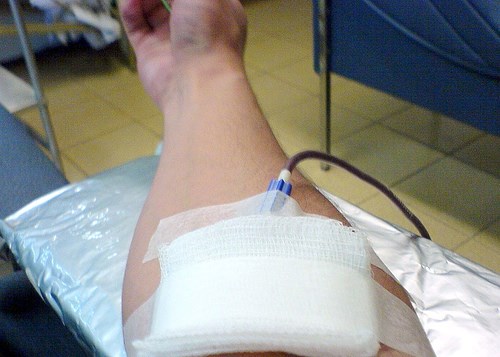After an appeal for blood donations was sent out in September by Canadian Blood Services, the situation is improving but more blood is still needed.
"We considered the inventory at critical levels," said Susan Matsumoto, director of donor relations for Alberta, Saskatchewan, and the Northwest Territories.
At that time, there was a three-day supply of blood in the country, when the goal is to have seven or eight days' worth. What this means is that if there was no incoming blood, hospitals would run out of their blood supply in three days. Since then, there has been a 20 per cent increase in donations and Canadian Blood Services is on track to make their projected October numbers. But that doesn't mean the crisis is over.
"We still need, and this is a national number, about 25,000 donations until the end of October," Matsumoto said. "We certainly made gains. We're on the right track, but we still have an ongoing need."
Matsumoto credits the dip in donations to the fact that people are busier and vacationing in the summer. As well, there were higher no-show rates at blood clinics than the organization is used to seeing. September was an unusually slow month for donations and this, coupled with a usual slow summer, led to the call for blood donations.
"It brought national inventory to the levels where we were very concerned," she said.
Canadian Blood Services is trying to combat this by reaching out to the media, increasing staff at the national contact centre to call more donors, increasing clinic hours where possible, and reaching out to their partners.
"It's all hands on deck in terms of our effort," Matsumoto said.
Canadian Blood Services has a special need for O and A blood types - O because it's a universal donor, and A because hospitals tend to use a lot of it.
What people don't tend to know about blood is how much can be used in a single situation. A patient having heart surgery could use up to five units of blood, which is the amount of blood taken from five donors. Car crash victims could use up to 50, while people with leukemia sometimes need up to eight units a week.
"It's kind of shocking," said Matsumoto, who added that these are routine situations.
"I hope (it will continue to improve)," Matsumoto said. She said that there was an increase in donations immediately following reaching out to the media, but they need people to continue to donate to maintain a "strong, steady supply" of blood.
Canadian Blood Services said on their website to make sure donors do the following:
"Make sure you have had a substantial meal.
Be well hydrated - start drinking one - two litres of water in the days before you donate and at least one litre the day of your donation.
Get some rest - make sure you have had a good night's sleep prior to donating.
Feel well the day you donate (no sore throat, cold, etc).
Bring your Blood Donor Card or photo ID (identification with full name and signature, or full name and photograph required)."
Matsumoto says that anyone who has questions about eligibility or the donation process should call the national contact centre at 1-888-2-DONATE.
For people in Humboldt who want to donate blood, there will be a blood donation clinic here on Dec. 30 and one in Warman on Jan. 27. Otherwise, the closest donation centre is in Saskatoon. Appointments can be made via phone, online, or their new app.




